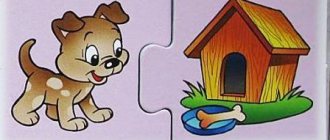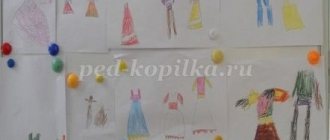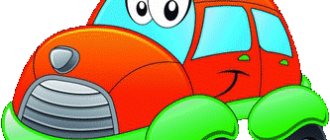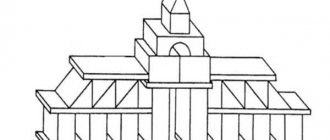Progress of the game: The teacher explains the rules of the game:
• I will tell a story in which you should notice something that does not happen.
“In the summer, when the sun was shining brightly, the boys and I went for a walk. They made a snowman out of snow and started sledding.” "Spring has come. All the birds flew away to warmer lands. The bear crawled into his den and decided to sleep all spring.”
4. Didactic game “What time of year?”
Objectives: to learn to correlate the description of nature in poetry or prose with a certain time of year; develop auditory attention and quick thinking.
How to play: Children sit on a bench. The teacher asks the question “When does this happen?”
and reads a text or riddle about different seasons.
5. Didactic game “Where can I do what?”
Goals: activation in speech of verbs used in a certain situation.
Classification methodology
There are several criteria for classifying games and dividing them into groups. This makes it possible to choose an activity that best suits specific pedagogical tasks.
Self-study
Selection of materials for classes
Depending on the content, classes are divided into various types aimed at improving a particular skill in children. Accordingly, various materials are used, such as:
- toys;
- Pictures;
- various household items;
- board games that you can print out yourself.
How to Learn the Alphabet with a 4, 5, or 6 Year Old
The role of the teacher in organizing games
Based on the type of lesson, level of training of the group and their independence, the teacher’s influence on the process can be either primary, for example, as a leader, or secondary, when he observes from the side and only if necessary directs actions in the right direction.
Progress of the game: The teacher asks questions, the children answer them.
What can you do in the forest? (Walk; pick berries, mushrooms; hunt; listen to birdsong; relax)
.
What can you do on the river? What are they doing in the hospital?
6. Didactic game “Which, which, which?”
Objectives: to teach how to select definitions that correspond to a given example or phenomenon; activate previously learned words.
Progress of the game: The teacher names a word, and the players take turns naming as many signs as possible that correspond to this subject. Squirrel - red, nimble, big, small, beautiful.
Coat - warm, winter, new, old...
Mom is kind, affectionate, gentle, beloved, dear...
House - wooden, stone, new, panel...
7. Didactic game “Finish the sentence”
Goals: learn to complement sentences with a word of the opposite meaning, develop attention .
Progress of the game: The teacher begins the sentence, and the children finish it, only they say words with the opposite meaning.
Sugar is sweet. and pepper -... (bitter)
.
In summer the leaves are green, and in autumn... (yellow)
.
The road is wide and there is a path. (narrow)
.
8. Didactic game “Find out whose sheet it is”
Goals: to teach to recognize a plant by its leaf (name a plant by its leaf and find it in nature, develop attention .
How to play: While walking, collect fallen leaves from trees and bushes. Show the children, ask them to find out which tree it is from and find similarities with the unfallen leaves.
9. Didactic game “Guess what kind of plant”
Goals: learn to describe an object and recognize it by description, develop memory , attention.
Progress of the game: The teacher invites one child to describe the plant or make a riddle about it. The other children must guess what kind of plant it is. 10. Didactic game “Who am I?”
Goals: learn to name a plant, develop memory , attention.
Progress of the game: The teacher quickly points to the plant. The one who is the first to name the plant and its shape (tree, shrub, herbaceous plant) gets a chip.
11. Didactic game “Who has who”
Goals: consolidate knowledge about animals, develop attention and memory.
Progress of the game: The teacher names the animal, and the children name the cub in the singular and plural. The child who correctly names the cub gets a chip.
12. Didactic game “Who (what)
flies?
Goals: consolidate knowledge about animals, insects, birds, develop attention and memory.
How to play: Children stand in a circle. The selected child names an object or animal, raises both hands up and says: “Flying”
.
When an object that flies is called, all children raise both hands up and say “Flying”
If not, they don’t raise their hands. If one of the children makes a mistake, he leaves the game.
13. Didactic game “What kind of insect?”
Goals: to clarify and expand ideas about the life of insects in the fall, to learn to describe insects by characteristic features, to cultivate a caring attitude towards all living things, to develop attention .
Progress of the game: Children are divided into 2 subgroups. One subgroup describes the insect, and the other must guess who it is. You can use riddles. Then another subgroup asks their questions.
14. Didactic game “Hide and Seek”
Goals: to learn to find a tree by description, to consolidate the ability to use prepositions in speech: for, about, before, next to, because of, between, on; develop auditory attention .
Progress of the game: According to the teacher’s instructions, some of the children hide behind trees and bushes. The presenter, according to the teacher’s instructions, searches (find who is hiding behind a tall tree, low, thick, thin)
.
15. Didactic game “Who can name the most actions?”
Goals: learn to select verbs denoting actions, develop memory , attention.
Progress of the game: The teacher asks questions, the children answer with verbs. For each correct answer, children receive a chip.
• What can you do with flowers? (pluck, smell, look, water, give, plant)
• What does a janitor do? (sweeps, cleans, waters, clears snow from paths)
16. Didactic game “What happens?”
Objectives: learn to classify objects by color, shape, quality, material, compare, contrast, select as many items as possible that fit this definition; develop attention .
Conducting didactic classes
Pedagogical classes for children in the senior group of kindergarten involve techniques that can be divided into three categories.
- Verbal. The priority goal of developing the speech center in children of the older group is to form a comprehensive vocabulary and a set of non-verbal skills.
- Visual. Abstract thinking is poorly developed in children of this age. They have a leading visual-figurative model of perception. The teacher’s task is to combine these methods of perceiving information by demonstrating visual images.
- Practical. It is important that during the lesson the child creatively embodies his vision of the game in various forms of artistic implementation: draws the object of the game; I made an applique (this method fits in very well after playing with numbers); made a craft or molded something out of snow if the activity takes place outside in winter.
Progress of the game: Tell us what happens:
green - cucumber, crocodile, leaf, apple, dress, Christmas tree....
wide - river, road, ribbon, street...
The one who can name the most words wins.
17. Didactic game “What kind of bird is this?”
Objectives: to clarify and expand ideas about the life of birds in autumn, to learn to describe birds by their characteristic features; develop memory ; cultivate a caring attitude towards birds.
Progress of the game: Children are divided into 2 subgroups. Children of one subgroup describe the bird, and the other have to guess what kind of bird it is. You can use riddles. Then another subgroup asks their questions.
18. Didactic game “Riddle, we will guess”
Objectives: consolidate knowledge about garden plants; the ability to name their signs, describe and find them by description, develop attention .
Progress of the game: Children describe any plant in the following order6 shape, color, taste. The driver should recognize the plant from the description.
19. Didactic game “It happens - it doesn’t happen”
(with a ball)
Goals: to develop memory , attention, thinking, speed of reaction.
Progress of the game: The teacher says phrases and throws the ball, and the children must answer quickly.
Snow in winter... (happens)
Frost in summer...
(doesn't happen)
Frost in summer... (doesn't happen)
drops in the summer...
(doesn’t happen)
20. Didactic game “The third odd one”
(plants)
Objectives: to consolidate children’s knowledge about the diversity of plants, to develop memory , speed of reaction.
Progress of the game: The teacher names 3 plants (trees and shrubs, one of which is “superfluous”
.
For example, maple, linden, lilac. Children must determine which one is the “extra” one
and clap their hands.
(Maple, linden - trees, lilac - bush)
21. Didactic game “Game of riddles”
Goals: expand the stock of nouns in the active dictionary.
How to play: Children sit on a bench. The teacher asks riddles. The child who guessed it comes out and asks the riddle himself. For solving a riddle, he receives one chip. The one who collects the most chips wins.
22. Didactic game “Did you know.”
Goals: enrich children's vocabulary with animal names, consolidate knowledge of models, develop memory and attention.
How to play: You need to prepare the chips in advance. The teacher places images of animals in the first row, birds in the second, fish in the third, and insects in the fourth. The players take turns calling first the animals, then the birds, etc. And if the answer is correct, they place the chip in a row. The one who places the most chips wins.
23. Didactic game “When does this happen?”
Goals: to consolidate children’s knowledge of the parts of the day, to develop speech and memory.
Progress of the game: The teacher lays out pictures depicting the life of children in kindergarten: morning exercises, breakfast, classes, etc. Children choose any picture and look at it. For the word "morning"
all children pick up
a picture associated with the morning and explain their choice.
Then day, evening, night. For each correct answer, children receive a chip. 24. Didactic game “And then what?”
Objectives: to consolidate children’s knowledge about the parts of the day, about the activities of children at different times of the day; develop speech and memory.
Progress of the game: Children sit in a semicircle. The teacher explains the rules of the game:
• Remember when we talked about what we do in kindergarten throughout the day? Now let’s play and find out if you remember everything. We will talk about this in order. What do we do in kindergarten in the morning? Whoever makes a mistake will sit on the last chair, and everyone else will move.
You can introduce a game moment: the teacher sings the song “I have a pebble. Who should I give it to? Who should I give it to? He will answer"
.
The teacher begins: “We came to kindergarten. We played in the area. And what happened then?
He passes the pebble to one of the players. He replies:
“We did gymnastics”
-
“And then?”
Passes the pebble to another child.
The game continues until the children say the last thing - going home.
Note. It is advisable to use a pebble or other object, since it is not the one who wants it that answers, but the one who gets it. This forces all children to be attentive and ready to respond.
25. Didactic game “When do you do this?”
Goal: consolidate cultural and hygienic skills and knowledge of the parts of the day, develop attention , memory, speech.
Progress of the game: The teacher names one child. Then he depicts some action, for example, washing his hands, brushing his teeth, cleaning his shoes, combing his hair, etc., and asks: “When do you do this?”
If a child answers that he brushes his teeth in the morning, the children correct him:
“Morning and evening
. One of the children can act as the leader.
26. Didactic game “Highlight the word”
Goals: to teach children to clearly pronounce polysyllabic words loudly, to develop auditory attention .
Progress of the game: The teacher pronounces the words and invites the children to clap their hands when they hear words that contain the sound “z”
(mosquito song)
.
(Bunny, mouse, cat, castle, goat, car, book, bell)
The teacher should pronounce the words slowly, pause after each word so that the children can think.
27. Didactic game “Tree, bush, flower”
Goals: consolidate knowledge of plants, expand children's horizons, develop speech and memory.
Progress of the game: The presenter says the words “Tree, bush, flower.”
and walks around the children. Stopping, he points to the child and counts to three; the child must quickly name what the leader stopped at. If the child does not have time or names incorrectly, he is eliminated from the game. The game continues until one player remains.
28. Didactic game “Where does it grow?”
Objectives: to teach to understand the processes occurring in nature; give an idea of the purpose of plants; show the dependence of all life on earth on the state of the vegetation cover; develop speech .
Progress of the game: The teacher names different plants and shrubs, and the children choose only those that grow with us. If children grow up, they clap their hands or jump in one place (you can choose any movement; if not, they remain silent.
Apple, pear, raspberry, mimosa, spruce, saxaul, sea buckthorn, birch, cherry, sweet cherry, lemon, orange, linden, maple, baobab, tangerine.
If the children did it successfully, they can list the trees faster:
plum, aspen, chestnut, coffee. Rowan, plane tree. Oak, cypress\. Cherry plum, poplar, pine.
At the end of the game, the results are summed up as to who knows the most trees.
29. Didactic game “Who is who (with what)
will?"
Goal: to develop speech activity and thinking.
Progress of the game: Children answer the adult’s question: “Who will it be (or what will it be)
... egg, chicken, boy, acorn, seed, egg, caterpillar, flour, iron, brick, cloth, etc.? If the children come up with several options, for example, from an egg - a chicken, a duckling, a chick, a crocodile. Then they receive additional forfeits.
Or the teacher asks: “Who was the chick before (an egg, bread (flour, a car (metal))
.
30. Didactic game “Summer or Autumn”
Goal: consolidate knowledge of the signs of autumn, differentiating them from the signs of summer; develop memory , speech; nurturing dexterity.
Progress of the game: The teacher and children stand in a circle. Educator. If the leaves turn yellow, this is... (and throws the ball to one of the children. The child catches the ball and says, throwing it back to the teacher: “Autumn”
).
Educator. If the birds fly away, this is... Etc.
31. Didactic game “Be careful”
Goal: differentiation of winter and summer clothing; develop auditory attention , speech hearing; increasing vocabulary.
Listen carefully to the verses about clothing, so that you can then list all the names that appear in these verses. Call it summer first. And then winter.
32. Didactic game “Take - don’t take”
Purpose: differentiation of forest and garden berries; increasing vocabulary on the topic “Berries”
;
develop auditory attention .
How to play: Children stand in a circle. The teacher explains that he will pronounce the names of forest and garden berries. If children hear the name of a wild berry, they should sit down, and if they hear the name of a garden berry, they should stretch, raising their arms up.
Strawberries, blackberries, gooseberries, cranberries, red currants, strawberries, black currants, lingonberries, raspberries.
33. Didactic game “What do they plant in the garden?”
Goal: to learn to classify objects according to certain characteristics (by their place of growth, by their use)
;
develop quick thinking and
auditory attention.
Progress of the game: Children, do you know what is planted in the garden? Let's play this game: I will name different objects, and you listen carefully. If I name what is planted in the garden, you will answer “Yes”
, if what doesn’t grow in the garden, you say
“No”
. Whoever makes a mistake leaves the game.
• Carrots (yes, cucumber (yes), plum (no, beets (yes)
etc.
34. Didactic game “Who will collect it most quickly?”
Purpose: to teach children to group vegetables and fruits; cultivate quick reaction to the teacher’s words, endurance and discipline.
Progress of the game: Children are divided into two teams: “Gardeners”
and
"Gardeners"
. On the ground there are models of vegetables and fruits and two baskets. At the command of the teacher, the teams begin to collect vegetables and fruits, each in their own basket. Whoever collects first raises the basket up and is considered the winner.
35. Didactic game “Who needs what?”
Purpose: to exercise in the classification of objects, the ability to name things necessary for people of a certain profession; develop attention .
Educator: - Let's remember what people of different professions need to work. I will name his profession, and you will tell him what he needs for work.
The teacher names a profession, the children say what is needed for work. And then in the second part of the game, the teacher names the object, and the children say for what profession it might be useful.
36. Didactic game “Make no mistake”
Goal: consolidate children’s knowledge about different sports, develop resourcefulness , intelligence, attention; cultivate a desire to play sports.
Progress of the game: The teacher lays out cut pictures depicting various sports: football, hockey, volleyball, gymnastics, rowing. In the middle of the picture is an athlete , you need to pick up everything he needs for the game.
Using this principle, you can make a game in which children will select tools for various professions. For example, a builder: he needs tools - a shovel, trowel, paint brush, bucket; machines that make the work of a builder easier - a crane, an excavator, a dump truck, etc. In the pictures - people of those professions that children are introduced to throughout the year: a cook, a janitor, a postman, a salesman, a doctor, a teacher, a tractor driver, a mechanic, etc. They select images of the objects of their labor. The correctness of execution is controlled by the picture : from small pictures it should turn out to be a large, whole one
37. Didactic game “Guess it!”
Goal: to learn to describe an object without looking at it, to identify essential features in it, to recognize an object by description; develop memory , speech.
Progress of the game: At the teacher’s signal, the child who received the chip stands up and makes a description of any object from memory, and then passes the chip to the person who will guess. Having guessed, the child describes his item, passes the chip to the next one, etc.
38. Didactic game “Finish the sentence”
Goal: learn to complete sentences with a word of the opposite meaning; develop memory , speech.
Progress of the game: The teacher begins the sentence, and the children finish it, only they say words that are opposite in meaning.
Sugar is sweet and pepper is... (bitter)
In summer the leaves are green, and in autumn -... (yellow)
The road is wide and the path is…. (narrow)
The ice is thin, but the trunk is ... (thick)
39. Didactic game “Where is what?”
Goal: to learn to identify words with a given sound from a group of words, from a speech stream; consolidate the correct pronunciation of certain sounds in words; develop attention .
Progress of the game: The teacher names the object and invites the children to answer where they can put it. For example:
- “Mom brought bread and put it in ... (breadbox)
.
• Masha poured sugar... Where? (Into the sugar bowl)
• Vova washed his hands and put down the soap. Where? (On a soapbox)
40. Didactic game “Catch up with your shadow”
Purpose: to introduce the concept of light and shadow; develop speech .
Progress of the game: Educator: Who will guess the riddle?
I'm going - she's going,
I'm standing - she's standing
If I run, she runs. Shadow
On a sunny day, if you stand with your face, back or side to the sun, a dark spot will appear on the ground, this is your reflection, it is called a shadow. The sun sends its rays to the earth, they spread in all directions. Standing in the light, you block the path of the sun's rays, they illuminate you, but your shadow falls on the ground. Where else is there shade? What does it look like? Catch up with the shadow. Dance with the shadow.
41. Didactic game “Finish the sentence”
Goal: learn to complete sentences with a word of the opposite meaning; develop memory , speech.
Progress of the game: The teacher begins the sentence, and the children finish it, only they say words that are opposite in meaning.
Sugar is sweet and pepper is... (bitter)
In summer the leaves are green, and in autumn -... (yellow)
The road is wide and the path is…. (narrow)
The ice is thin, but the trunk is ... (thick)
42. Didactic game “Who has what color?”
Goal: to teach children to recognize colors, consolidate the ability to identify objects by color, develop speech and attention.
Progress of the game: The teacher shows, for example, a green square of paper. Children name not a color, but an object of the same color: grass, sweater, hat, etc.
43. Didactic game “What subject”
Goal: to teach to classify objects according to a certain criterion (size, color, shape, to consolidate children’s knowledge about the size of objects; to develop quick thinking .
Didactic classes as a topic for teacher self-education
Throughout his professional career, a preschool teacher constantly improves himself, practices and improves his speech and methods of interaction with children and their parents. And didactic classes play a significant role in this, facilitating the learning process for young students. Self-education on this topic is possible by reading relevant literature.
Explanation of English reading rules for a child
It is no secret that the most successful form of learning for preschoolers is a didactic game. This can only be achieved with proper design, planning and presentation of the material by the teacher, so a very important factor is the continuous self-development of the teacher.
Progress of the game: Children sit in a circle. The teacher says:
• Children, objects that surround us come in different sizes: large, small, long, short, low, high, wide, narrow. During classes and on walks, we saw many objects of different sizes. Now I will name one word, and you will list which objects can be called in one word.
The teacher has a pebble in his hands. He gives it to the child who must answer.
• Long, says the teacher and passes the pebble to the neighbor.
• Dress, rope, day, fur coat, the children remember.
• Wide,” the teacher suggests the next word.
Children call: road, street, river, ribbon, etc.
The game is also played with the aim of improving children’s ability to classify objects by color and shape. The teacher says:
• Red.
Children take turns answering: berry, ball, flag, star, car, etc.
— Round (ball, sun, apple, wheel, etc.)
44. Didactic game “What can animals do?”
Goal: learn to create a wide variety of verbal combinations; expand the semantic content of the word in the mind; develop memory .
Progress of the game: Children turn into “animals”
.
Everyone must tell what they can do, what they eat, how they move. The one who tells the story correctly receives a picture of an animal.
• I'm a red squirrel. I jump from branch to branch. I make provisions for the winter: I collect nuts, dry mushrooms.
• I am a dog, cat, bear, fish, etc.
45. Didactic game “Come up with another word”
Goal: expand vocabulary; develop attention .
Progress of the game: The teacher says, “Come up with one word and another, similar one. You can say: milk bottle, or you can say milk bottle.” Cranberry jelly (cranberry jelly)
;
vegetable soup (vegetable soup)
;
mashed potatoes (
mashed potatoes ) .
46. Didactic game “Choose similar words”
Goal: to teach children to clearly pronounce polysyllabic words loudly; develop memory attention .
Progress of the game: The teacher pronounces words that sound similar: spoon - cat, ears - guns. Then he pronounces one word and invites the children to choose others that are similar in sound: spoon (cat, leg, window, cannon (fly, dryer, cuckoo, bunny (boy, finger)
etc.
47. Didactic game “Who will remember more?”
Goal: to enrich children’s vocabulary with verbs denoting the actions of objects; develop memory , speech.
Progress of the game: Carlson asks to look at the pictures and tell them what they are doing and what else they can do.
A blizzard is sweeping, blizzarding, blizzarding.
The rain is pouring, drizzling, drizzling, dripping, starting, lashing, ...
Crow—flies, croaks, sits, eats, perches, drinks, howls, etc.
48. Didactic game “What else do they talk about?”
Purpose: to consolidate and clarify the meaning of polysemantic words; cultivate a sensitive attitude to the compatibility of words in meaning, develop speech .




